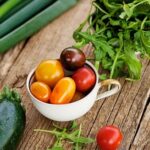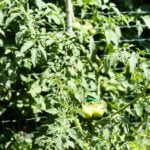Is it safe to use plastic edging for vegetable gardens? When it comes to creating defined borders and pathways in your garden, edging plays a crucial role in keeping everything organized and looking neat. However, the choice of material for your garden edging can have implications on the safety of your produce and the environment. In this article, we will explore the use of plastic edging specifically for vegetable gardens, weighing its benefits against potential risks.
Using plastic edging in vegetable gardens has become a popular choice for many gardeners due to its affordability, durability, and versatility. Plastic is lightweight and easy to install, making it a convenient option for creating clean lines and boundaries within the garden. It also requires minimal maintenance and is resistant to rotting or corrosion.
While plastic edging may offer several advantages, there are also potential drawbacks that must be considered. One concern is the leaching of harmful chemicals from the plastic material into the soil, which could impact the health of plants and ultimately affect the safety of consuming homegrown vegetables. Additionally, the environmental impact of using plastic edging must be taken into account, including its long-term effects on soil quality and water contamination.
Pros of Using Plastic Edging
Plastic edging is a popular choice for many vegetable gardens due to its affordability, durability, and versatility. One of the primary advantages of using plastic edging is its cost-effectiveness. Plastic is generally cheaper than other materials such as metal or wood, making it an attractive option for gardeners on a budget.
Additionally, plastic edging is known for its durability, as it can withstand exposure to the elements without rotting or corroding like other materials might. This means that once installed, plastic edging can last for years without needing replacement, providing long-term value for gardeners.
Another benefit of using plastic edging in vegetable gardens is its versatility. Plastic edging comes in a variety of colors, shapes, and sizes, allowing gardeners to customize their garden borders to suit their specific preferences and needs.
Whether you prefer a seamless look with subtle black plastic edging or want to add a pop of color with red or green options, there are plenty of choices available. Additionally, plastic edging can be easily manipulated and cut to fit the contours of your garden beds, making it suitable for both straight and curved designs.
Furthermore, plastic edging is lightweight and easy to install compared to other options such as metal or stone. This makes it an ideal choice for DIY garden projects where simplicity and ease of use are important factors. With minimal effort required for installation and maintenance, plastic edging proves to be a practical choice for many vegetable gardens seeking defined borders at an affordable cost.
Cons of Using Plastic Edging
Pros of Using Plastic Edging in Vegetable Gardens:
When it comes to choosing the right edging for your vegetable garden, there are several options to consider, including plastic. While plastic edging has its advantages, such as affordability and versatility, it also comes with some potential drawbacks that should be taken into account before making a decision. Here are some cons of using plastic edging in vegetable gardens:
1. Leaching of Harmful Chemicals: One of the main concerns with using plastic edging in vegetable gardens is the potential leaching of harmful chemicals into the soil. Over time, exposure to sunlight and weather can cause the plastic to break down, releasing toxic substances that can negatively impact plant growth and soil quality.
2. Environmental Impact: Another drawback of using plastic edging is its environmental impact. Once the plastic has served its purpose, it may end up in landfills or as litter, contributing to pollution and harming wildlife. Additionally, the production of plastic edging also has environmental consequences, such as energy consumption and greenhouse gas emissions.
3. Potential Damage to Plants: Plastic edging may pose a risk of damaging plants in the garden if not installed or maintained properly. Sharp edges or protruding pieces of plastic could potentially injure plants or create obstacles for their growth.
In light of these potential drawbacks, it’s important for gardeners to carefully weigh the pros and cons before deciding whether to use plastic edging in their vegetable gardens. There are alternative options available that may offer more environmentally friendly and sustainable choices for garden edging.
Environmental Impact
Plastic edging has become a popular choice for many gardeners due to its affordability, durability, and versatility. However, the use of plastic in vegetable gardens can have significant environmental implications that should be carefully considered. One of the main concerns with using plastic edging is its long-term impact on soil health and water quality.
The environmental impact of plastic edging in vegetable gardens includes:
- Soil contamination: Plastic edging can release harmful chemicals into the soil over time, which can affect the health of the plants and ultimately, the quality of the produce.
- Water pollution: As plastic degrades, it can release microplastics into the surrounding soil and water, leading to potential contamination of groundwater and nearby water sources.
- Waste generation: When plastic edging reaches the end of its lifespan, it contributes to the growing issue of plastic waste in landfills and ecosystems.
As such, it is essential for gardeners to consider alternative options that minimize these environmental impacts while still providing effective edging for their vegetable gardens.
Alternative options to consider include:
- Metal: Metal landscape edging provides a durable and long-lasting option that does not pose the same environmental risks as plastic.
- Wood: Natural wood materials can be used as an organic alternative to plastic, offering a more sustainable choice for garden edging.
- Natural materials: Rocks, stones, or even plants themselves can serve as natural barriers for defining garden beds without introducing synthetic materials into the environment.
While some gardeners may still opt for using plastic edging due to its convenience and low cost, it is important to implement best practices for minimizing environmental harm. This may include properly disposing of old or damaged plastic edging, avoiding chemical treatments near plastic borders, and regularly inspecting for signs of degradation or leaching.
By carefully considering the environmental implications and taking proactive steps towards responsible usage, it is possible to mitigate some of the negative effects associated with using plastic edging in vegetable gardens.
Harmful Chemicals
Plastic edging is a commonly used material in vegetable gardens due to its affordability, durability, and versatility. However, one of the primary concerns associated with using plastic edging in these settings is the potential for harmful chemicals to leach into the soil and impact the health of the crops.
This concern is particularly relevant given the widespread use of plastics and their known environmental impact. To understand whether it is safe to use plastic edging for vegetable gardens, it is essential to address this issue and explore its potential implications.
When it comes to potentially harmful chemicals leaching from plastic edging, one of the primary concerns is the effect it may have on soil quality and ultimately on the health of the crops grown in the garden. The leaching of chemicals from plastics has been well-documented in various environmental contexts, and there is valid concern about how these substances may affect not only plant growth but also human health through consumption of contaminated produce.
Studies have shown that certain chemicals found in plastics, such as phthalates, bisphenol A (BPA), and polyvinyl chloride (PVC), have the potential to leach into surrounding soil and water. These substances can have detrimental effects on soil fertility, water quality, and ultimately crop yield.
Furthermore, when humans consume crops that have been exposed to these chemicals, there may be additional health risks involved. Given these concerns, it is crucial for gardeners to carefully consider whether the benefits of using plastic edging outweigh these potential drawbacks.
| Harmful Chemical | Potential Impact |
|---|---|
| Phthalates | Leaching may affect soil fertility |
| Bisphenol A (BPA) | Leaching may contaminate water sources |
| Polyvinyl Chloride (PVC) | Can harm crop yield if exposed to soil |
Alternative Edging Options
When it comes to edging options for vegetable gardens, plastic is not the only choice available. There are several alternative materials that can be used, each with its own set of advantages and disadvantages. Metal edging, such as aluminum or steel, provides a sleek and long-lasting option for defining the borders of a vegetable garden. However, metal edging can be more expensive than plastic and may require additional maintenance to prevent rust or corrosion over time.
Wood is another popular choice for edging in vegetable gardens due to its natural look and versatility. It can be easily shaped and installed, allowing for creative designs and patterns within the garden. However, wood edging may rot over time when exposed to moisture and may need regular upkeep to maintain its appearance and functionality.
Natural materials such as stone or brick offer a timeless and durable option for edging in vegetable gardens. They can add a touch of elegance to the garden while providing a sturdy border that helps keep plants contained. However, natural materials can be more labor-intensive to install and may come with a higher upfront cost compared to plastic edging.
Each alternative material has its own pros and cons that should be considered when choosing the right edging for a vegetable garden. Factors such as cost, durability, maintenance requirements, and aesthetic appeal should all be taken into account before making a decision. Ultimately, the best choice will depend on individual preferences and priorities when it comes to creating a safe and functional border for a vegetable garden.
Best Practices for Using Plastic Edging
Proper Installation
When deciding to use plastic edging for your vegetable garden, it is important to ensure proper installation. This includes securing the edging firmly into the ground to prevent any shifting or movement. Make sure to dig a trench along the edge of the garden and insert the plastic edging deep enough to provide stability. Additionally, consider using metal stakes or anchors to further secure the edging in place.
Regular Inspection and Maintenance
To minimize potential risks associated with plastic edging, it is essential to regularly inspect and maintain the edging. Check for any signs of damage, such as cracks or breakage, that could result in harmful chemicals leaching into the soil. Additionally, be proactive in addressing any wear and tear that may occur over time due to weather or other environmental factors. By staying vigilant with regular inspections and maintenance, you can effectively mitigate potential issues.
Mindful Use of Chemicals
When using plastic edging in your vegetable garden, it is important to be mindful of any chemicals that may come into contact with the material. Avoid using harsh chemical fertilizers or pesticides near the plastic edging, as these substances can potentially interact with the material and lead to leaching of harmful compounds into the soil. Instead, opt for organic gardening practices that promote a more natural and sustainable approach.
By following these best practices, you can maximize the benefits of using plastic edging while minimizing potential risks. Ultimately, ensuring proper installation, conducting regular inspections and maintenance, and being mindful of chemical usage can help create a safer environment for your vegetable garden while utilizing plastic edging.
Conclusion
In conclusion, the use of plastic edging for vegetable gardens has both advantages and disadvantages. While plastic edging is affordable, durable, and versatile, there are concerns about harmful chemicals leaching into the soil, potential damage to plants, and its environmental impact on soil and water quality. It is important for gardeners to weigh these factors carefully when considering whether to use plastic edging in their vegetable gardens.
Considering the potential drawbacks of using plastic edging, it may be worth exploring alternative options such as metal, wood, or natural materials. These alternatives may have less of an environmental impact and pose fewer risks to the health of the crops. Additionally, it is important for gardeners to consider best practices for using plastic edging if they do choose this option, such as proper installation and maintenance to minimize potential risks.
Ultimately, while some gardeners may choose to use plastic edging for its affordability and versatility, others may opt for alternative materials in order to prioritize environmental sustainability and the health of their crops. Each gardener should carefully evaluate their individual priorities and concerns when making this decision for their vegetable garden.
Frequently Asked Questions
Is It Safe to Line Garden Beds With Plastic?
Lining garden beds with plastic can have both benefits and drawbacks. On the one hand, it can help prevent weeds from growing and keep moisture in the soil. However, it can also hinder proper drainage and lead to waterlogging. It’s important to weigh the pros and cons before deciding whether or not to line garden beds with plastic.
What Is the Best Edging for a Vegetable Garden?
The best edging for a vegetable garden ultimately depends on personal preference and specific needs. Some popular options include using natural materials like stone or wood, or opting for metal or plastic edging. Each material has its own advantages and disadvantages, so it’s important to consider factors such as durability, aesthetics, and budget before making a decision.
Is Plastic Safe for Vegetable Garden?
Using plastic in a vegetable garden is generally considered safe as long as certain precautions are taken. For example, using food-grade plastics that are free of harmful chemicals is essential to ensure the safety of vegetables grown in the garden.
Additionally, properly disposing of old or damaged plastic materials will help prevent any potential harm to the environment and human health.

If you’re looking to get into vegetable gardening, or are just looking for some tips on how to make your current garden better, then you’ve come to the right place! My name is Ethel and I have been gardening for years. In this blog, I’m going to share with you some of my best tips on how to create a successful vegetable garden.





